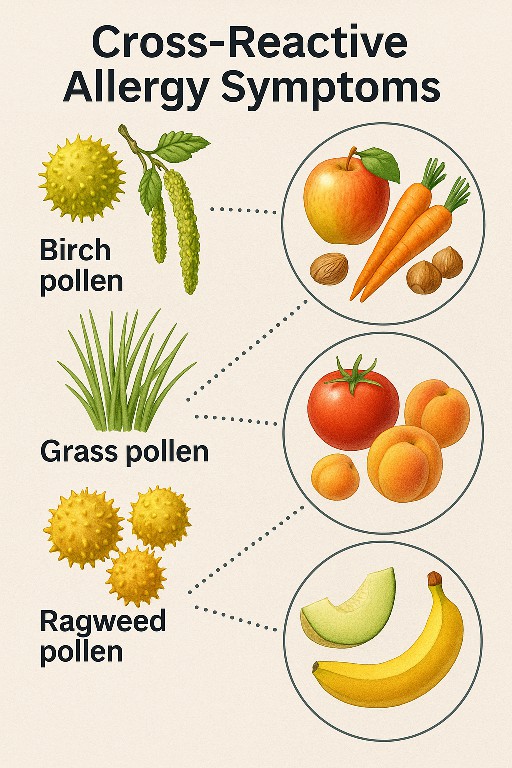Understanding Cross-Reactive Allergy Symptoms
Allergy season often brings familiar symptoms like sneezing, itchy eyes, and congestion. Yet, some people notice reactions to foods they previously tolerated. This confusing situation can be explained by cross-reactive allergy symptoms, a condition in which the immune system mistakes one allergen for another due to similar protein structures.

What Are Cross-Reactive Allergy Symptoms?
Cross-reactivity happens when the immune system identifies a harmless substance as a threat because it shares traits with a known allergen. For example, someone allergic to birch pollen might react to raw apples. This isn’t a new allergy to apples, but rather a mistaken immune response.
In many cases, people are unaware of the link between their seasonal allergies and food sensitivities. Consequently, they may not realize that their symptoms are part of a broader pattern.
Pollen and Food Cross-Reactive Allergy Symptoms
Many individuals who suffer from hay fever also experience symptoms after eating certain raw fruits or vegetables. This is due to the similarities between pollen proteins and plant-based proteins.
Some common examples include:
- Birch pollen → Apples, carrots, hazelnuts
- Grass pollen → Tomatoes, peaches
- Ragweed → Melons, bananas
These symptoms are often mild and include tingling or swelling in the mouth and throat. Fortunately, cooking the food usually destroys the problematic proteins.
Latex and Food Cross-Reactivity
Another notable case involves those allergic to natural rubber latex. They may also react to:
- Avocados
- Bananas
- Kiwis
- Chestnuts
This connection is known as latex-fruit syndrome. Because the proteins in these fruits resemble those in latex, the immune system gets confused. Reactions can range from mild itching to more severe symptoms like difficulty breathing.
When Dust Mites Mimic Shellfish
One of the more surprising links involves dust mites and shellfish. Both contain a protein called tropomyosin, which can trigger an allergic response. As a result, individuals with dust mite allergies might experience symptoms when eating shrimp, crab, or lobster for the first time.
While this overlap isn’t common, it’s important to be cautious and consult a specialist before introducing new foods if you have a known allergy.
Recognizing the Signs of Cross-Reactions
Although symptoms vary, some common signs of these immune mix-ups include:
- Itchy mouth or throat
- Swelling of the lips or tongue
- Sneezing or nasal congestion
- Hives or skin rashes
- Breathing difficulties
Most reactions are mild, but in rare instances, they may lead to anaphylaxis. Therefore, staying informed and alert is crucial.
Diagnosing Cross-Reactive Allergy Symptoms
To confirm whether you’re experiencing cross-reactive allergy symptoms, an allergist will examine your history, run skin prick tests, and possibly order blood work. A more advanced method, component-resolved diagnostics (CRD), can pinpoint the exact proteins causing the response.
This helps differentiate between a true food allergy and a pollen-related reaction. For instance, someone reacting to apples due to birch pollen may not need to eliminate all apple-based foods.
How to Manage Allergy Symptoms Naturally
Fortunately, several natural strategies can help minimize discomfort from cross-reactive allergy symptoms.
Cook Your Fruits and Vegetables
Cooking alters protein structures, reducing the chance of triggering a reaction. People who can’t tolerate raw carrots or apples often eat them without issue when cooked.
Wash Produce Thoroughly
Removing surface pollen and other residues can lessen exposure and lower the risk of symptoms, especially during high pollen seasons.
Time Your Diet With the Seasons
Allergy flare-ups tend to worsen during specific times of the year. Avoiding trigger foods when pollen counts are high may reduce reactions considerably.
Support Your Body With Natural Remedies
Some natural compounds act as antihistamines, which can relieve minor symptoms. Helpful substances include:
- Quercetin – found in onions and apples
- Vitamin C – from citrus and peppers
- Bromelain – in pineapple
Used alongside medical treatments, these can offer additional support.
Medical Support for Cross-Reactive Allergy Symptoms
When natural methods fall short, medical treatments can offer relief and long-term solutions.
Antihistamines and Nasal Sprays
Over-the-counter antihistamines are effective in treating mild cases. Nasal sprays with corticosteroids may also reduce inflammation and ease breathing.
Immunotherapy as a Long-Term Option
Allergy shots (immunotherapy) expose the body to small doses of allergens over time. This method can help reduce sensitivity and control cross-reactive allergy symptoms in the long run.
Emergency Preparedness
In rare but serious cases, an epinephrine auto-injector may be necessary. If you’ve had a severe reaction in the past, always carry one and inform others about your condition.
Should You See an Allergy Specialist?
If you’ve noticed reactions to foods linked with your seasonal allergies, it’s time to consult a professional. An allergist can guide you through testing, create a treatment plan, and recommend dietary changes if needed.
Even if your symptoms are mild now, understanding and managing cross-reactive allergy symptoms can prevent complications later on.
Final Thoughts
Although often overlooked, cross-reactive allergy symptoms affect a significant number of people with seasonal or environmental allergies. By learning about the causes and adopting both natural and medical strategies, you can improve your well-being and reduce surprises in your diet. Whether you’re reacting to raw fruit or shellfish, identifying the link and acting early makes all the difference.
